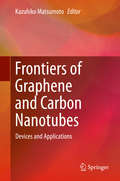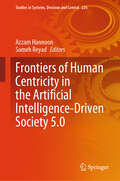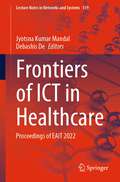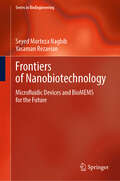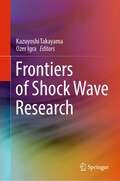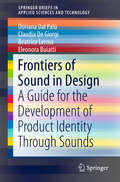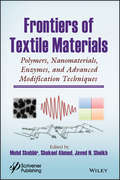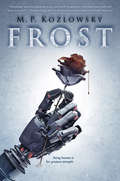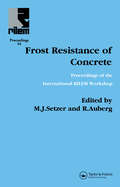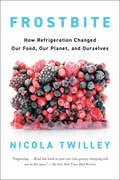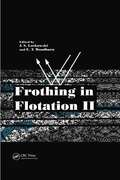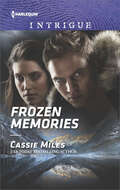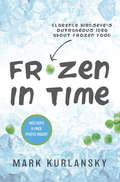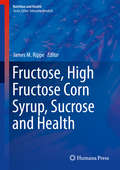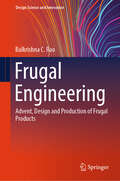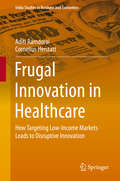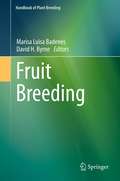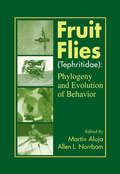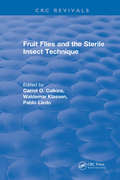- Table View
- List View
Frontiers of Graphene and Carbon Nanotubes
by Kazuhiko MatsumotoThis book focuses on carbon nanotubes and graphene as representatives of nano-carbon materials, and describes the growth of new technology and applications of new devices. As new devices and as new materials, nano-carbon materials are expected to be world pioneers that could not have been realized with conventional semiconductor materials, and as those that extend the limits of conventional semiconductor performance. This book introduces the latest achievements of nano-carbon devices, processes, and technology growth. It is anticipated that these studies will also be pioneers in the development of future research of nano-carbon devices and materials. This book consists of 18 chapters. Chapters 1 to 8 describe new device applications and new growth methods of graphene, and Chapters 9 to 18, those of carbon nanotubes. It is expected that by increasing the advantages and overcoming the weak points of nanocarbon materials, a new world that cannot be achieved with conventional materials will be greatly expanded. We strongly hope this book contributes to its development.
Frontiers of Human Centricity in the Artificial Intelligence-Driven Society 5.0 (Studies in Systems, Decision and Control #226)
by Azzam Hannoon Sameh ReyadAccording to Serpa (in MDPI encyclopedia) [3], Society 5.0 can be realized as a concept and a guide for social development, with a profound impact on current societal structures in multiple levels. Society 5.0 achieves advanced convergence between cyberspace and physical space, enabling AI-based on big data and robots to perform or support as an agent the work and adjustments that humans have done up to now. Deguchi et al., [4] define Society 5.0 as a highly intelligent society based on generation, processing, exchange of data, and more specifically knowledge, through the connection of the physical environment with the cyberspace. Achieving Society 5.0 with these attributes would enable the world to realize economic development while solving key social problems. It would additionally contribute to achieving the SDGs established by the United Nations. Despite the differences in formulation of the names of these periods and societies, it is obvious that each of them became a basis for step like growth in developed society; at, specific time periods, scale, character and depth of these changes are different in different countries. Consequently, to address the aims of the book, it seeks exploratory, empirical, interpretive, and theoretical research built on either primary or secondary data. The approaches suggested are not exhaustive and can be extended upon by the researchers. In addition, the book will contribute towards the UN’s sustainable development goals. In support of UN’s efforts towards a more digital economy, this book aims to debate and discuss the history, genesis, future, opportunities, and challenges of transitioning to Society 5.0. and provides a holistic perspective on a variety of topics special topics which contribute towards the optimal attainment of the SDGs, particularly in terms of socialdimensions. Finally, this book provides a platform for researchers, academics, and professionals to the transition and technological enablers of industrial revolutions through empirical or exploratory studies that use a variety of innovative approaches. The target audience of the book includes researchers and scholars who will find in its comprehensive knowledge about industry 4, industry 5, society 5 and its contribution to economic growth and sustainable development goals (SDGs). Furthermore, the book’s secondary target audience are teachers, managers, strategists, professionals, governments, and policymakers.
Frontiers of ICT in Healthcare: Proceedings of EAIT 2022 (Lecture Notes in Networks and Systems #519)
by Debashis De Jyotsna Kumar MandalThe book includes original unpublished contributions presented at the Seventh International Conference on Emerging Applications of Information Technology (EAIT 2022), organized by Computer Society of India, Kolkata, Chapter during March 30–31, 2022. The book covers the topics such as image processing for smart healthcare applications, computer vision and pattern recognition for health care, Internet of Health Things, 5G and beyond in smart health care for sustainable cities.
Frontiers of Nanobiotechnology: Microfluidic Devices and BioMEMS for the Future (Series in BioEngineering)
by Seyed Morteza Naghib Yasaman RezaeianThis book provides a comprehensive overview of microfluidic-assisted devices and bioMEMS, covering their fundamental principles, manufacturing processes, and biomedical applications. It explores the design, fabrication, and integration of microfluidic devices and MEMS, emphasizing their role in microscale physics and biomedical engineering. Key topics include micropumps, biosensors, and organ-on-a-chip systems, with applications in drug discovery, disease diagnosis, and tissue engineering. The book also discusses recent advances in the field, particularly the integration of biosensors with microfluidic systems, highlighting their growing impact on biomedical research and healthcare innovations.
Frontiers of Performability Engineering: In Honor of Prof. K.B. Misra (Risk, Reliability and Safety Engineering)
by Durga Rao KarankiThis book presents recent advances in performability analysis methods and their applications in different fields. It covers various aspects of performability such as quality, reliability, maintainability, availability, safety, security, and sustainability that are essential in complex engineering systems such as electrical grids, chemical plants, naval defense systems, structures, nuclear reactors, railways, etc. This book is a collection of research works contributed by the former students of Professor KB Mishra who is a renowned researcher in reliability engineering. This book is useful for the researchers and professionals working in the area of performability engineering.
Frontiers of Shock Wave Research
by Ozer Igra Kazuyoshi TakayamaThe book contains 12 chapters written by well-known shock wave researchers from seven different countries. Each researcher provides a brief description of his main research interests and results, thereby providing the readers with an excellent view of shock wave research conducted in the past fifty years. It also provides hints as to what still needs further investigation. It will be an excellent guide for young researchers entering the field of shock wave phenomena. Among the described investigations are the following topics: Blast wave interaction with a body when the body is in the area of interference of two blast waves moving in different directions; equation of state for water based on the shock Hugoniot data; Mach waves occurring over a backward facing edge in supersonic flow; shock waves in dusty gas; shock wave interaction with various bodies; three shock interactions.
Frontiers of Sound in Design: A Guide For The Development Of Product Identity Through Sounds (SpringerBriefs in Applied Sciences and Technology)
by Doriana Dal Palù Claudia De Giorgi Beatrice Lerma Eleonora BuiattiThis book serves as a guide to developing and designing the right sound to enhance a product’s identity, its use, its affordance and its acceptance by consumers. It is of interest to designers, researchers, R&D departments, marketing experts and industries involved in the exploration of the new frontiers now offered by sound. We are all immersed in an intangible world of sounds; however, the fact that only an infinitesimal part of the sound to which we are exposed has been wittingly created is often ignored. An interdisciplinary and trans-disciplinary approach encompassing design methods and design engineering, psychology and cognitive ergonomics, acoustics and psychoacoustics contributes to the improvement of product sound development. Providing readers with an overview of design methods in which sound becomes a new requirement, the book investigates the role of sound from the consumer viewpoint, presents several tools and practical examples of sensory design tools and projects, and lastly, introduces a new tool and method developed expressly to support the design of product sound.
Frontiers of Textile Materials: Polymers, Nanomaterials, Enzymes, and Advanced Modification Techniques
by Shakeel Ahmed Mohd Shabbir Javed N. SheikhThe book “Frontiers and Textile Materials will deal with the important materials that can be utilized for value-addition and functionalization of textile materials. The topics covered in this book includes the materials like enzymes, polymers, etc. that are utilized for conventional textile processing and the advanced materials like nanoparticles which are expected to change the horizons of textiles. The futuristic techniques for textile processing like plasma are also discussed.
Fronts, Waves and Vortices in Geophysical Flows
by Jan-Bert FlorMost well known structures in planetary atmospheres and the Earth's oceans are jets or fronts interacting with vortices on a wide range of scales. The transition from one state to another, such as in unbalanced or adjustment flows, involves the generation of waves as well as the interaction of coherent structures with these waves. This book presents a fluid mechanics perspective to the dynamics of fronts and vortices and their interaction with waves in geophysical flows. It provides a basic physical background for modeling coherent structures in a geophysical context, and it gives essential information on advanced topics such as spontaneous wave emission and wavemomentum transfer in geophysical flows. Based on a set of lectures by leading specialists, this text is targeted at graduate students, researchers and engineers in geophysics and environmental fluid mechanics.
Frost (Scholastic Press Novels)
by M. P. KozlowskyCinder meets The Walking Dead in a chilling futuristic fairy tale that will reboot everything you thought about family, love… and what it means to be human.Before he died, Frost's father uploaded his consciousness into their robot servant. But the technology malfunctioned, and now her father fades in and out. So when Frost learns that there might be medicine on the other side of the ravaged city, she embarks on a dangerous journey to save the only living creature she loves.With only a robot as a companion, Frost must face terrors of all sorts, from outrunning the vicious Eaters. . .to talking to the first boy she's ever set eyes on. But can a girl who's only seen the world through books and dusty windows survive on her own?
Frost Resistance of Concrete
by R Auberg M.J. SetzerThis book forms the proceedings of the international workshop to be held in Essen, Germany. This workshop summarises the conclusion of the technical committee's investigations into the resistance of concrete to freeze-thaw attack, specific in this to resistance with or without de-icing chemicals. It presents the RILEM recommendations on testing the
Frostbite: How Refrigeration Changed Our Food, Our Planet, and Ourselves
by Nicola TwilleyWinner of the James Beard Award for Literary Writing "Engrossing...hard to put down." — The New York Times Book Review&“Frostbite is a perfectly executed cold fusion of science, history, and literary verve . . . as a fellow nonfiction writer, I bow down. This is how it's done.&” — Mary Roach, author of Fuzz and StiffAn engaging and far-reaching exploration of refrigeration, tracing its evolution from scientific mystery to globe-spanning infrastructure, and an essential investigation into how it has remade our entire relationship with food—for better and for worseHow often do we open the fridge or peer into the freezer with the expectation that we&’ll find something fresh and ready to eat? It&’s an everyday act—but just a century ago, eating food that had been refrigerated was cause for both fear and excitement. The introduction of artificial refrigeration overturned millennia of dietary history, launching a new chapter in human nutrition. We could now overcome not just rot, but seasonality and geography. Tomatoes in January? Avocados in Shanghai? All possible.In Frostbite, New Yorker contributor and cohost of the award-winning podcast Gastropod Nicola Twilley takes readers on a tour of the cold chain from farm to fridge, visiting off-the-beaten-path landmarks such as Missouri&’s subterranean cheese caves, the banana-ripening rooms of New York City, and the vast refrigerated tanks that store the nation&’s orange juice reserves. Today, nearly three-quarters of everything on the average American plate is processed, shipped, stored, and sold under refrigeration. It&’s impossible to make sense of our food system without understanding the all-but-invisible network of thermal control that underpins it. Twilley&’s eye-opening book is the first to reveal the transformative impact refrigeration has had on our health and our guts; our farms, tables, kitchens, and cities; global economics and politics; and even our environment.In the developed world, we&’ve reaped the benefits of refrigeration for more than a century, but the costs are catching up with us. We&’ve eroded our connection to our food and redefined what &“fresh&” means. More important, refrigeration is one of the leading contributors to climate change. As the developing world races to build a US-style cold chain, Twilley asks: Can we reduce our dependence on refrigeration? Should we? A deeply researched and reported, original, and entertaining dive into the most important invention in the history of food and drink, Frostbite makes the case for a recalibration of our relationship with the fridge—and how our future might depend on it.
Froth!: The Science of Beer
by Mark DennyBest Beer Book in the United States of America, 2009 Gourmand World Cookbooks AwardsEver wonder where the bubbles in your beer came from, which way they are going, and why? Have you considered the physical differences among ales, lambics, and lagers? Do you contemplate your pint? Accomplished homebrewer and physicist Mark Denny has crafted a scientifically sound and witty investigation of the physics and chemistry of beer. He recounts and explains the history of and key technological advances in brewing, provides basic instructions for making your own—including a scientific-yet-accessible account of the changes in appearance during each stage of the process—and looks at the fascinating physical phenomena contained within a pint of beer. Along the way he defines the main concepts and terms involved in the process and shows how you can subject the technical aspects of brewing to scientific analysis. If you've ever been curious about how beer is made, why it froths so well, and what makes different types... well... different, then Froth! is for you.
Froth!: The Science of Beer
by Mark Denny“A theoretical physicist’s exploration of the math and science behind the beer-brewing process. Packed with humor, history, and DIY enthusiasm.” —Seed MagazineBest Beer Book in the United States of America, 2009 Gourmand World Cookbook AwardsEver wonder where the bubbles in your beer came from, which way they are going, and why? Have you considered the physical differences among ales, lambics, and lagers? Do you contemplate your pint?Accomplished homebrewer and physicist Mark Denny has crafted a scientifically sound and witty investigation of the physics and chemistry of beer. He recounts and explains the history of and key technological advances in brewing, provides basic instructions for making your own—including a scientific-yet-accessible account of the changes in appearance during each stage of the process—and looks at the fascinating physical phenomena contained within a pint of beer. Along the way he defines the main concepts and terms involved in the process and shows how you can subject the technical aspects of brewing to scientific analysis.If you’ve ever been curious about how beer is made, why it froths so well, and what makes different types . . . well . . . different, then Froth! is for you.“Froth! earns a solid ‘A’ for bringing science, brewing, and good writing together.” —Beerfestivals.org“Books about beer tend to be either purely descriptive or wholly scientific. Rarely does a book combine the two, much less with genuine wit and charm. Froth! . . . is the exception. It is a great joy to read and contains a wealth of information for a wide audience . . . Highly recommended.” —Choice
Frothing in Flotation II: Recent Advances in Coal Processing, Volume 2 (Recent Advances In Coal Processing Ser. #Vol. 2.)
by J. S. Laskowski E. T. WoodburnDr. J. S. Laskowski has written several papers on frother-collector interactions and the effect of such interactions on flotation kinetics, and on frothers chemistry and frothing. He is founder and Editor-in-Chief of the journal, Coal Preparation. Dr. E. T. Woodburn has published numerous papers on flotation froth and flotation kinetics. Frothing in Flotation, published in honor of Jan Leja, appeared in 1989. Many important contributions on various aspects of flotation froth properties and behavior and the relationship between froth appearance and flotation performance have appeared since, and this volume intends to summarize these achievements. Flotation kinetics involves a number of mass transfer processes with some of them being critically determined by the behavior of froth. Since froth is complex, and controlled experimentation is difficult, the froth phase was, until recently, either ignored or treated entirely empirically. With wide applications of flotation columns, the behavior of the froth is now often recognized as being dominant in determining flotation performance, and the research in this area is one of the most actively pursued.
Frozen Fire
by Bill Evans Marianna JamesonBill Evans and Marianna Jameson first teamed up to write Category 7, vividly portraying the devastating impact of a powerful hurricane on New York City. Now Evans and Jameson return with Frozen Fire, another edge-of-the-seat thriller that mixes atmospheric science with cutting-edge technology. Eager to exploit a potentially lucrative energy source, billionaire Dennis Cavendish has begun to tap the crystalline methane under the floor of the Atlantic Ocean. Eco-terrorism kills his science team and releases gigatons of poisonous methane into the water and atmosphere, causing untold deaths. If the release isn't stopped, all life on Earth will soon disappear. Suspected of the sabotage and marooned far from home, Cavendish's beautiful and brainy security chief, Victoria Clark, along with methane expert Dr. Sam Briscoe and the US government, must find a way to seal the break in the ocean floor and nullify the methane that is already poisoning the planet.
Frozen Memories: Fearless Gunfighter Texas Witness Frozen Memories
by Cassie MilesAn NSA agent deals with amnesia and the threat of a nuclear attack in this romantic suspense novel by a USA Today bestseller.Their mission is compromised. Their cover is blown. And FBI Special Agent Spence Malone has found his partner—and love of his life—disoriented and suffering from drug-induced amnesia. NSA cybercrimes expert Angelica Thorne has forgotten her name, her mission and, worst of all, Spence and their nights of passion. And now they’re in a race against an unseen enemy bent on nuclear destruction. Spence vows to protect her and help her remember . . . everything. All Angelica knows for sure is that when Spence holds her in his arms, she feels so right. Why, then, does everything else seem so wrong?
Frozen in Time
by Mark KurlanskyNonfiction for kids interested in science, biography, and early entrepreneurs, this work explores the life story of Clarence Birdseye, the man who revolutionized the frozen food industry and changed the way people eat all over the world. Adapted from Mark Kurlansky's adult work Birdseye: The Adventures of a Curious Man. Adventurer and inventor Clarence Birdseye had a fascination with food preservation that led him to develop and patent the Birdseye freezing process and start the company that still bears his name today. His limitless curiosity spurred his other inventions, including the electric sunlamp, an improved incandescent lightbulb, and a harpoon gun to tag finback whales. This true story of an early inventor/entrepreneur is not only thrilling but also explains the science and early technology behind food preservation. Simultaneously available in a hardcover and trade paperback edition. Each edition includes an 8-page black-and-white photo insert.From the Hardcover edition.
Fructose, High Fructose Corn Syrup, Sucrose and Health
by James M. RippeThe metabolic and health effects of both nutritive and non-nutritive sweeteners are controversial, and subjects of intense scientific debate. These potential effects span not only important scientific questions, but are also of great interest to media, the public and potentially even regulatory bodies. Fructose, High Fructose Corn Syrup, Sucrose and Health serves as a critical resource for practice-oriented physicians, integrative healthcare practitioners, academicians involved in the education of graduate students and post-doctoral fellows, and medical students, interns and residents, allied health professionals and nutrition researchers, registered dietitians and public health professions who are actively involved in providing data-driven recommendations on the role of sucrose, HFCS, glucose, fructose and non-nutritive sweeteners in the health of their students, patients and clients. Comprehensive chapters discuss the effects of both nutritive and non-nutritive sweeteners on appetite and food consumption as well as the physiologic and neurologic responses to sweetness. Chapter authors are world class, practice and research oriented nutrition authorities, who provide practical, data-driven resources based upon the totality of the evidence to help the reader understand the basics of fructose, high fructose corn syrup and sucrose biochemistry and examine the consequences of acute and chronic consumption of these sweeteners in the diets of young children through to adolescence and adulthood. Fructose, High Fructose Corn Syrup, Sucrose and Health fills a much needed gap in the literature and will serve the reader as the most authoritative resource in the field to date.
Frugal Engineering: Advent, Design and Production of Frugal Products (Design Science and Innovation)
by Balkrishna C. RaoThis book presents a novel method of engineering to create advanced frugal products from scratch. It outlines a frugal design and frugal manufacturing approach, and delineates concepts and principles underlying different types of frugal innovations. The contents present advanced frugal innovations (AFIs) in a variety of sectors bringing out their widespread presence in rich and emerging economies of the world. This book discusses applications of such innovations in aerospace, automotive, healthcare, particle-physics, and other important sectors, emphasizing the significant potential of frugal engineering. AFIs are not jugaad, rather, they are engineered to harness frugality with cutting-edge research using classical and modern scientific principles. Frugal engineering uses advances in science and other knowledge-areas, including 3D printing, biomimetics, artificial intelligence, Industry 4.0, and others, to frugalize pillars of engineering in modern problems. This book willbe of interest to academics, industry professionals, policymakers, product designers and developers, among others. It introduces the reader to the wonderful world of frugal engineering. In doing so, this book shines light on the significant difference that meticulous creation of these innovations through systematic application of science, engineering, and other knowledge-bases can make to the cause of sustainable development. Frugal engineering of AFIs is indispensable to achieving the sustainable development goals. We can help manage our every growing need for energy and resources effectively by going frugal in the current age of climate change.
Frugal Innovation
by Jaideep Prabhu Navi RadjouThis free e-short excerpt from Frugal Innovation: How to Do More with Less includes the foreword by Unilever’s CEO Paul Polman, the preface, a detailed case study on Aetna, a leading US health insurance company, and the conclusion from the book. Long practiced in resource-constrained emerging markets, frugal innovation is now being adopted in developed economies by pioneers like Unilever and Aetna to serve the needs of cost-conscious and environmentally-aware consumers in the US and Europe. With an estimated trillion-dollar global market for frugal products, and with potentially huge cost savings to be gained, frugal innovation has begun to revolutionize business and to reshape management thinking worldwide. The complete edition of Frugal Innovation is available in paperback and ebook wherever books are sold.
Frugal Innovation in Healthcare
by Aditi Ramdorai Cornelius HerstattThis book focuses on how companies are innovating with regard to the Bottom-of-the-Pyramid (BOP) − the lowest socio-economic segment, and the organizational conditions they need to be successful. The authors use several examples of disruptive innovations for this market, particularly in the Indian healthcare sector. Low-cost, specialty hospital chains like Aravind Eye Care and Narayana Hrudayalaya have brought down the cost of certain medical procedures significantly. The Indian conglomerate Tata Group and the American healthcare giant GE Healthcare have also developed affordable products targeted at the lowest-income segments in India. The authors present an in-depth analysis of these companies and present their insightful results on disruptive innovation and the ever-challenging BOP market.
Fruit Breeding
by Maria Luisa Badenes David H. ByrneFruit Breeding is the eighth volume in the Handbook of Plant Breeding series. Like the other volumes in the series, this volume presents information on the latest scientific information in applied plant breeding using the current advances in the field, from an efficient use of genetic resources to the impact of biotechnology in plant breeding. The majority of the volume showcases individual crops, complemented by sections dealing with important aspects of fruit breeding as trends, marketing and protection of new varieties, health benefits of fruits and new crops in the horizon. The book also features contributions from outstanding scientists for each crop species. Maria Luisa Badenes Instituto Valenciano de Investigaciones Agrarias (IVIA), Valencia, Spain David Byrne Department of Horticultural Sciences, Texas A&M University, College Station, TX, USA
Fruit Flies (Tephritidae): Phylogeny and Evolution of Behavior
by Martín Aluja Allen L. NorrbomFruit flies (Diptera: Tephritidae) are among the most destructive agricultural pests in the world, eating their way through acres and acres of citrus and other fruits at an alarming rate and forcing food and agriculture agencies to spend millions of dollars in control and management measures. But until now, the study of fruit flies has been traditi
Fruit Flies and the Sterile Insect Technique
by Carrol O. CalkinsThis book is a continuation of the development of the Sterile Insect Technique (SIT) specifically designed for use against, and management of, fruit flies. Several factors indicate an increased use of the SIT against fruit flies within the next decade.
